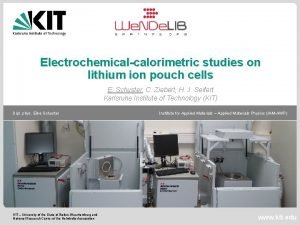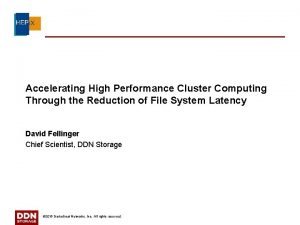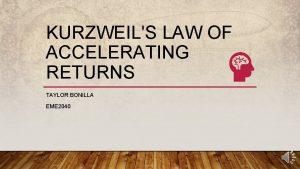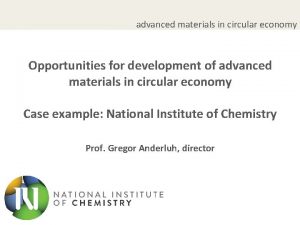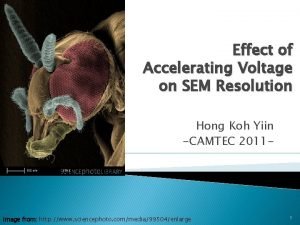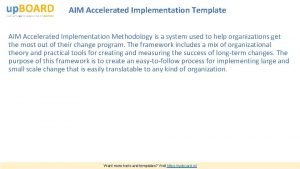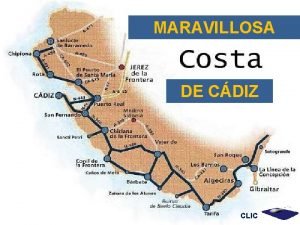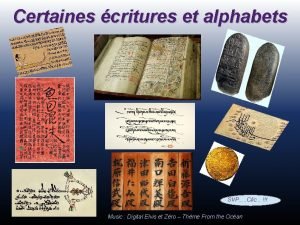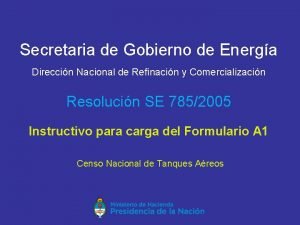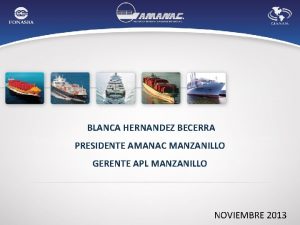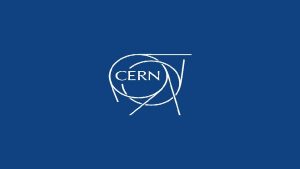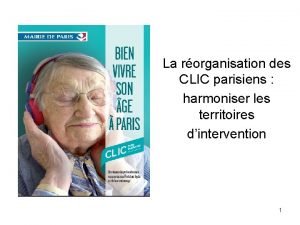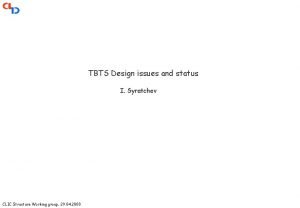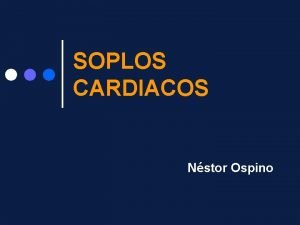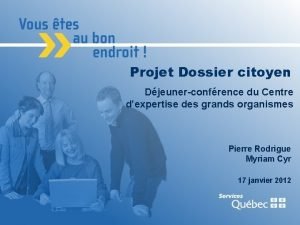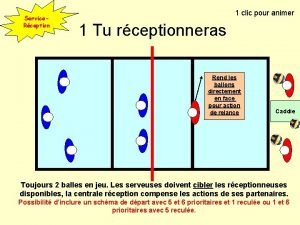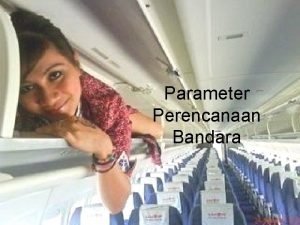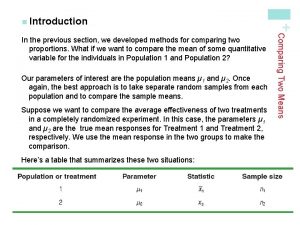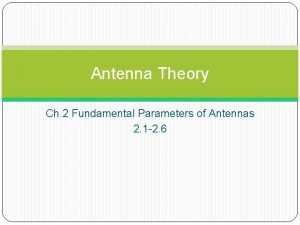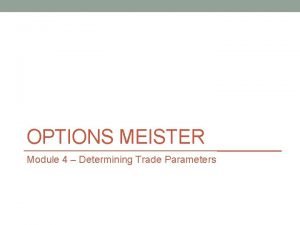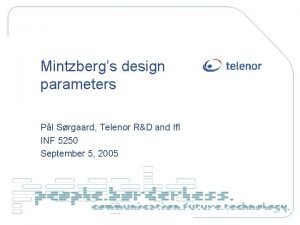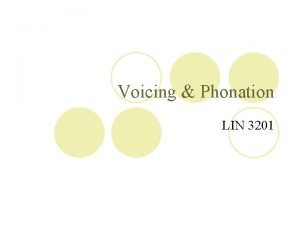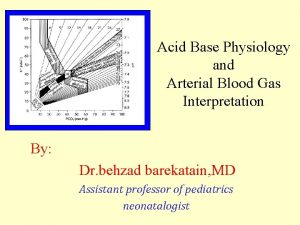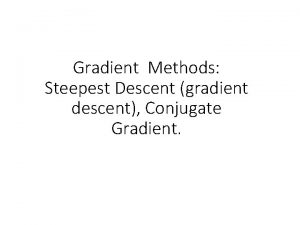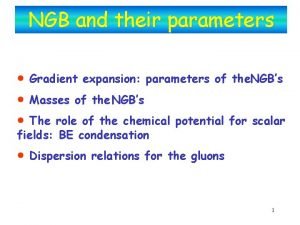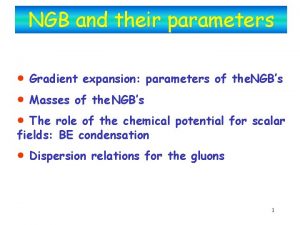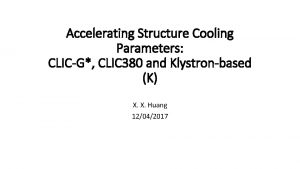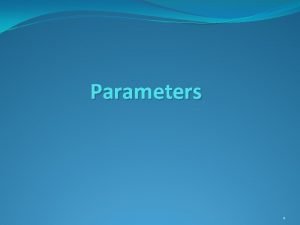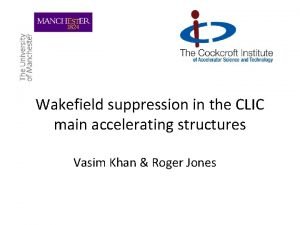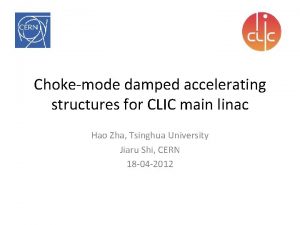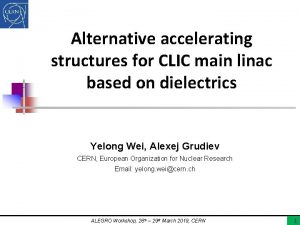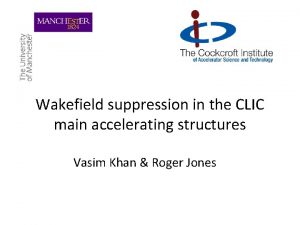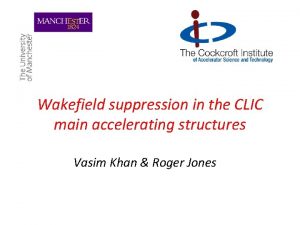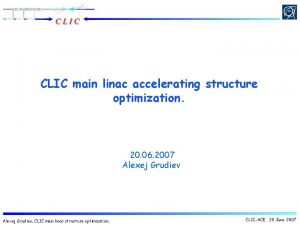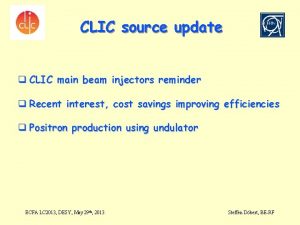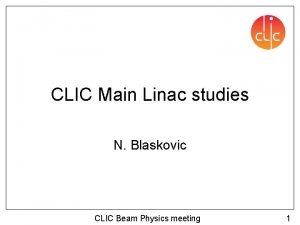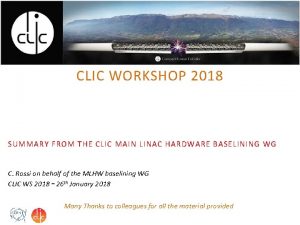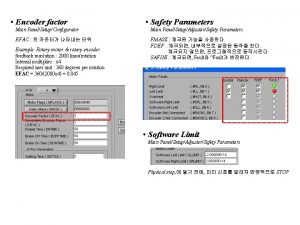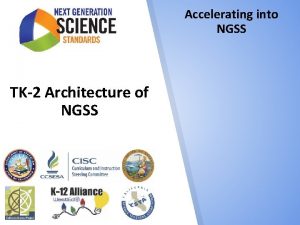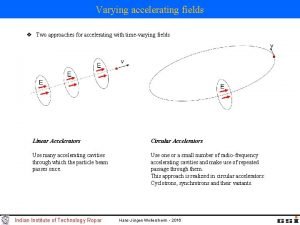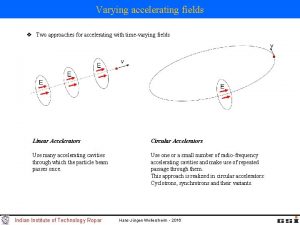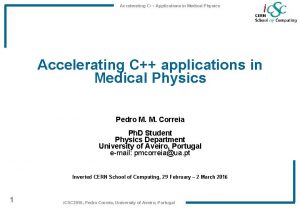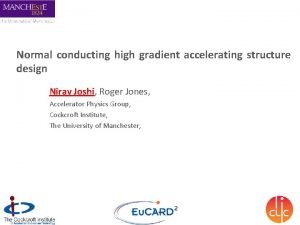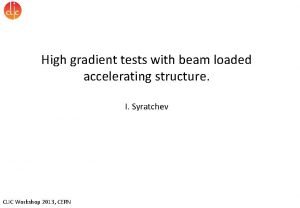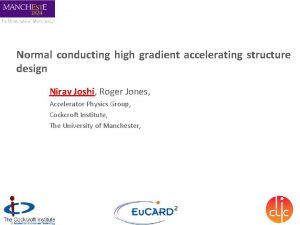CLIC MAIN PARAMETERS Accelerating Gradient What gradient could

































- Slides: 33

CLIC MAIN PARAMETERS • Accelerating Gradient – What gradient could reasonably be demonstrated by 2010 ? – What should be the nominal CLIC gradient ? • RF Frequency – What should be the CLIC nominal RF frequency ? – What should be the RF frequency of the RF components in CLEX ? J. P. Delahaye CLIC parameters 14/12/06 1

Motivation • Credibility – Trade off between attractive performances and parameters which can be reasonably demonstrated in the next three years • Ordering of components in CLEX – TBL, Two Beam Test stand, …. • Stand Alone Power Source (SAPS) developments: – Project definition with THALES and UK – FP 7 bid next year (frequency dependent technology from 18 GHz? ) • Optmisation of resources – Focus and minimisation of developments – Complementary with SLAC and KEK • Schedule – RF Frequency in CLEX to be defined now – CLIC Accelerating Field snf Frequency could possibly wait, but better decide simultaneusly for better coherency and work planning J. P. Delahaye CLIC parameters 14/12/06 2

Reminder: CLIC Gradient Specification in 1996? J. P. Delahaye CLIC parameters 14/12/06 3

Operational accelerating field • • Operation at 10 -6 Breakdown Rate (BR) Structure able to work without damage at 100 BR for efficient RF conditioning Damage induced by surface field or power? Temperature rise per pulse limited by fatigue Max surface field during RF commissioning Max accelerating gradient during RF conditionning Operational average accelerating gradient J. P. Delahaye CLIC parameters 14/12/06 4

Acceptable Trip Rate of CLIC accelerating structures (H. Braun for JPD presentation to ITRP on 28/06/04) Limits imposed by energy management Limits imposed by effect of RF break-down on beam Permissible trip rate per structure as function of structure reserve Ø Effect on beam of RF break-down in a structure not well known Can be measured in CTF 3 with probe beam (available 2007). Ø Vertical kick of DPY≈20 ke. V/c is sufficient to take beam out of collision. assuming this trip recovery scenario: Ø Assuming, in the worst case, that every beam pulse having suffered from one single structure breakdown does not contribute to the integrated luminosity: : For <1% luminosity loss: Trip rate per structure < 0. 05 h-1 1 over 10 6 RF pulses at 100 Hz repetition rate J. P. Delahaye CLIC parameters 14/12/06 5

RF Breakdown rates in structures Breakdown rates during RF conditioning of a CLIC structure equipped with Mo iris No reliable breakdown rates available for CLIC structures after RF conditioning Factor 10 reduction of breakdown rate of NLC structure by 5. 5 Me. V reduction in accelerating field (SLAC-PUB-10463, S. Doebert May 2004) 35 Me. V/m reduction in field for a 106 reduction in RF breakdown J. P. Delahaye CLIC parameters 14/12/06 6

Achieved Accelerating Gradient NLC demonstrated J. P. Delahaye Mo 70 ns Mo 60 ns Mo 40 ns Cu 40 ns 30 GHz CLIC parameters 14/12/06 NLC 50 ns CLIC Cu 11. 4 GHz CLIC goal 7

Achieved Field and breakdown rates J. P. Delahaye CLIC parameters 14/12/06 8

Accelerating Gradient at 10 -6 breakdown rate • Which can be reasonably demonstrated by 2010: Recommended: 100 MV/m – Unanimously recommended – Nearly already demonstrated several years ago with short pulses at 11. 4 GHz • with CLIC (small aperture) and NLC structures with short pulses (40 to 50 ns) • But with RF designs not compatible with acceptable luminosity performances (damping not sufficient) • HDS design = damping strong enough but presently lower performances – At 30 GHz: • Best performance achieved so far 95 MV/m with CU circular and 40 ns – Higher field not excluded but high(er) risk of failure • Magic material with max field of Mo and BR slope of Cu? 1 • New ideas? – Optimum trade off between optimism and realism J. P. Delahaye CLIC parameters 14/12/06 9

CLIC new target? J. P. Delahaye CLIC parameters 14/12/06 10

CLIC MAIN PARAMETERS • Accelerating Gradient – What gradient could reasonably be demonstrated by 2010 ? Recommended: 100 MV/m – What should be the nominal CLIC gradient ? Recommended: ? • RF Frequency – What should be the CLIC nominal RF frequency ? Recommended: ? – What should be the RF frequency of the RF components in CLEX ? Recommended: ? J. P. Delahaye CLIC parameters 14/12/06 11

CLIC Fo. M and cost optimisation (A. Grudiev) J. P. Delahaye CLIC parameters 14/12/06 12

Optimisation based on present model of structure limitations • Lower is the accelerating field (range 90 to 150 MV/m): – Higher is the figure of Merit for any RF frequency – Lower is the cost for any RF frequency • Cost flat bottom more or less independent of RF frequency and field in the range: 90 MV/m > Field > 100 MV/m 10 GHz > RF Frequency > 15 GHz • Improved Fo. M for low gradient due to higher efficiency • Cost (flat) minimum by trade off between Civil engineering and Power costs – Cost optimisation with lower field (50 to MV/m? ) in order to better identify minimum cost parameters? J. P. Delahaye CLIC parameters 14/12/06 13

Structure limitations J. P. Delahaye CLIC parameters 14/12/06 14

Physics model of the structure limitation J. P. Delahaye CLIC parameters 14/12/06 15

Sensitivity to Structure limitations J. P. Delahaye CLIC parameters 14/12/06 16

CLIC Nominal accelerating Gradient • Unanimously recommended: 100 MV/m • Corresponding to the optimum cost with present structure limitations – Trade off between Civil engineering and power costs – Factor two in P/C limitation could possibly raise minimum cost to 130 MV/m • Could possibly be demonstrated by 2010 • An increase of field in 2010 would be positively received – In case higher fields are demonstrated – In case optimum cost is shifted to higher fields due to lower structure limitations • Compatible with a 3 Te. V design on the CERN site – Up to 3 Te. V with overall extension: (3 Te. V/100 MV/m/ 0. 79 (filling factor) + 5 km (BDS) = 43 km: IP under Prevessin site and still shorter than ILC @ 1 Te. V (about 50 km) – extension to 5 Te. V more problematic with overall extension of 63 km and IP North of Prevessin Possible improvement of field (150 MV/m? ) in the (far) future? • Attractive enough in comparison with ILC – CLIC Acc. Fields >3 larger than 31. 5 MV/m at 500 Ge. V @ILC (presently unacceptable spread of fields in SC cavities) – Considered as the lowest field for which CLIC is worth pursuing • Higher fields not excluded but with (too) high risk of failure J. P. Delahaye CLIC parameters 14/12/06 17

Longitudinal section of a Linear Collider on CERN site– J. P. Delahaye CLIC parameters 14/12/06 18

Possible site for a Linear Collider at CERN – P 10 PO 8 PO 6 PO 4 P 5 PO 2 P 6 PO 1 P 2 P 8 PO 3 PO 5 PO 7 PO 9 10 km J. P. Delahaye P 11 CLIC parameters 14/12/06 19

CLIC MAIN PARAMETERS • Accelerating Gradient – What gradient could reasonably be demonstrated by 2010 ? Recommended: 100 MV/m – What should be the nominal CLIC gradient ? Recommended: 100 MV/m • RF Frequency – What should be the CLIC nominal RF frequency ? Recommended: ? – What should be the RF frequency of the RF components in CLEX ? Recommended: ? J. P. Delahaye CLIC parameters 14/12/06 20

CLIC RF frequency? • At 100 MV/m and following Alexej’s optimisation based on present model of structure limitations: – Figure of Merit maximum at 10 GHz (or lower? ) • Flat maximum in the range 10 to 15 GHz – Cost minimum at 12 GHz • Flat minimum in the range 10 to 15 GHz • Sensitivity to structure limitations (Improvement of P/C by factor 2) – Figure of Merit maximum at 14 GHz (or lower? ) • Flat maximum in the range 12 to 18 GHz – Cost minimum at 16 GHz • Flat minimum in the range 10 to 20 GHz • Challenging parameters (structure and linac) although more favorable at low frequency: – Longer structure length, larger and thicker iris, – Smaller repetition frequency but higher beam energy per pulse J. P. Delahaye CLIC parameters 14/12/06 21

CLIC Fo. M and cost optimisation (A. Grudiev) J. P. Delahaye CLIC parameters 14/12/06 22

Sensitivity to Structure limitations J. P. Delahaye CLIC parameters 14/12/06 23

J. P. Delahaye CLIC parameters 14/12/06 24

J. P. Delahaye CLIC parameters 14/12/06 25

RF frequency • Unanimity of all consulted experts – No support in favor of 30 GHz – Any (? ) lower frequency more favorable – Model of structure limitations certainly not perfect (especially scaling with frequency), lack of convincing physical explanation but coherent with the (too limited) available data and good enough to estimate the trend • Two various schemes (both valids with advantages and drawbacks): – Exploration of frequency range from 11. 4 to 30 GHz • • Measurements at 11, 4 GHz at SLAC and KEK (taking advantage of existing power sources) Measurements at 30 GHz in CTF 2 and 18 GHz in CLEX (middle of range between 12 and 30) Decide optimum frequency in 2010 In the meantime define CLIC parameters at 12 and 18 GHz – Focus on one single frequency at 12 GHz • Corresponding to minimum cost and maximum Fo. M • Even if optimum shifts to (slightly) higher frequencies, close to flat minimum and on the low frequency side • Distribute and share structure tests between CLEX, SLAC and KEK • Continuation of frequency scaling studies at 30 GHz in CTF 2 but no expected (good) surprise at intermediate frequency between 12 and 30 GHz J. P. Delahaye CLIC parameters 14/12/06 26

My personal recommendation • Favor RF frequency as low as possible close to optimum Fo. M & cost • Limited possible tests till 2010: – at CERN: 6 structures/year * 4 years = 24 structure tested distributed between CTF 2 and CLEX including accelerating structures, PETS, etc… • About 12 accelerating structures at the CLEX frequency: 6 structures at 30 GHz and 6 PETS – At SLAC: presently 2 test per year possibly doubled – At KEK: presently zero, not guaranteed (ILC commitment, ATF 2 focus) • Limited resources available: – Necessary RF developments and instrumentation for each frequency – Design at the new frequency (ies) • More chances of success if (too limited) resources and number of tests concentrated on one single frequency – RF scaling studied at 30 GHz in CTF 2 – No magic frequency • Coherence between tests and design at the same (unique) frequency J. P. Delahaye CLIC parameters 14/12/06 27

Motivation for RF frequency as low as possible – Closer to present standards and accumulated experience (except 30 GHz at CLIC) – Better physics conditions due to smaller distance between bunches (cumulative roll-up? ) – Easier fabrication (larger tools and more solid tools) – Reduced mechanical tolerances – More realistic design with longer pulse length and longer structures – Smaller damages and effect of breakdowns if spot independent of frequency) – Easier pumping and vacuum conditions – Simplified instrumentation due to larger beam dimensions and lower frequency spectrum – More efficient feedback due to longer pulse length – Less sensitivity to time and phase stability between drive and beams – Power production easier (smaller multiplication in drive beam generation = one single combiner ring? RF deflector at low frequency) – Easier Stand Alone Power Source (Klystrons available, No gyroklystrons need in SAPS? ) – …… J. P. Delahaye CLIC parameters 14/12/06 28

The beauty of 12 GHz? • Maximum Fo. M and minimum cost with the present model • Gradient nearly already demonstrated with short pulse (structure design or strong damping) • Reasonable (still too challenging) parameters – structure length = 15 cm; iris diameter = 3. 2 mm; iris thickness=0, 625 mm – Rf pulse length 150 ns; Rep frequency=210 Hz (130 Hz for L=2 10^34) • RF frequency multiplication by 4 in combiner ring (easier than 5 = nominal CTF 3 and equal to nominal CLIC) • RF power generation by PETS at first harmonic • Opens the possibility of single stage combination in CLIC – Possibly drive beam linac at 1. 5 GHz (with possible synergy with ILC MBK developments at 1. 3 GHz) and multiplication by 8 (2*4) • Stand alone power sources available: No gyroklystron necessary – Makes the best use of developments and equipments at SLAC and KEK • Common and complementary study with SLAC and KEK – Share and distribute the work • Accelerating field of 100 m. V/m = 1. 5 larger than dark current capture J. P. Delahaye CLIC parameters 14/12/06 29

Dark current capture and Iso-Fo. M fields J. P. Delahaye CLIC parameters 14/12/06 30

Home work • Need to convince (ourselves) and explain (community) why higher fields than 65 MV/m at NLC could be reached at the same frequency: – Small iris aperture by factor 2 for reduction of P/c limitation: • Strong wakefields = 2^4 = 16 with beam dynamics and alignment issues • Compensation by lower bunch charge (4), stonger focusing (? ), larger momentum spread (BNS? ), tighter alignment (? ) – Shorter pulse length: 65 MV/m/(150/400)^(1/6) = 76 MV/m – Advantage of HDS for Strong Damping – Advantage of Two Beam scheme to produce short pulses • Design of CLIC scheme adapted to 12 GHz and 100 MV/m • Raise any possible problem? J. P. Delahaye CLIC parameters 14/12/06 31

CLIC MAIN PARAMETERS • Accelerating Gradient – What gradient could reasonably be demonstrated by 2010 ? Recommended: 100 MV/m – What should be the nominal CLIC gradient ? Recommended: 100 MV/m • RF Frequency – What should be the CLIC nominal RF frequency ? Recommended: 12 GHz – What should be the RF frequency of the RF components in CLEX ? Recommended: 12 GHz J. P. Delahaye CLIC parameters 14/12/06 32

Conclusion • Reduction of field to 100 MV/m – with realistic chances of demonstration before 2010 – Attractive enough in terms of performances and cost. • Limitation surface field and temperature rise not anymore an issue: – Review design to adress P/c limitation – Are short pulses and strong damping still necessary? – Explore new Rf design (large phase advance and new ideas on couplers and power flow to first iris (Igor) • Focus on 12 GHz in CLIC and CLEX with complementary program at SLAC and KEK • Build-up the arguments to communicate and convince the community • Inform Physics and get the approval of the DG J. P. Delahaye CLIC parameters 14/12/06 33
 Accelerating rate calorimeter
Accelerating rate calorimeter Accelerating high performance
Accelerating high performance Law of accelerating returns
Law of accelerating returns Advanced materials
Advanced materials 50000x200
50000x200 Accelerating implementation methodology
Accelerating implementation methodology Clic
Clic Double entry for sales invoice
Double entry for sales invoice Alphabet protocananéen
Alphabet protocananéen Web res. 1102-404 y res. 785
Web res. 1102-404 y res. 785 Clic
Clic Palabras que empiecen con la letra a
Palabras que empiecen con la letra a Rey orozco
Rey orozco Clic paris emeraude
Clic paris emeraude Cern clic
Cern clic How to compute net of vat
How to compute net of vat Mesosistolico
Mesosistolico Au clair de la lune grand saint nicolas
Au clair de la lune grand saint nicolas Clic sécure citoyen
Clic sécure citoyen 1 clic reception
1 clic reception Imagenes de clic
Imagenes de clic Void main int main
Void main int main Be going to
Be going to What is the implied main idea of the passage
What is the implied main idea of the passage Faktor yang mempengaruhi ukuran lapangan terbang
Faktor yang mempengaruhi ukuran lapangan terbang Example of scheme of work
Example of scheme of work What is population of interest
What is population of interest Fundamental parameters of antenna
Fundamental parameters of antenna Lesson 3 parameters and return practice 8
Lesson 3 parameters and return practice 8 Trade parameters
Trade parameters Mintzberg design parameters
Mintzberg design parameters Pho nation menu
Pho nation menu Abg values
Abg values Lesson 3 parameters and return practice 7
Lesson 3 parameters and return practice 7
